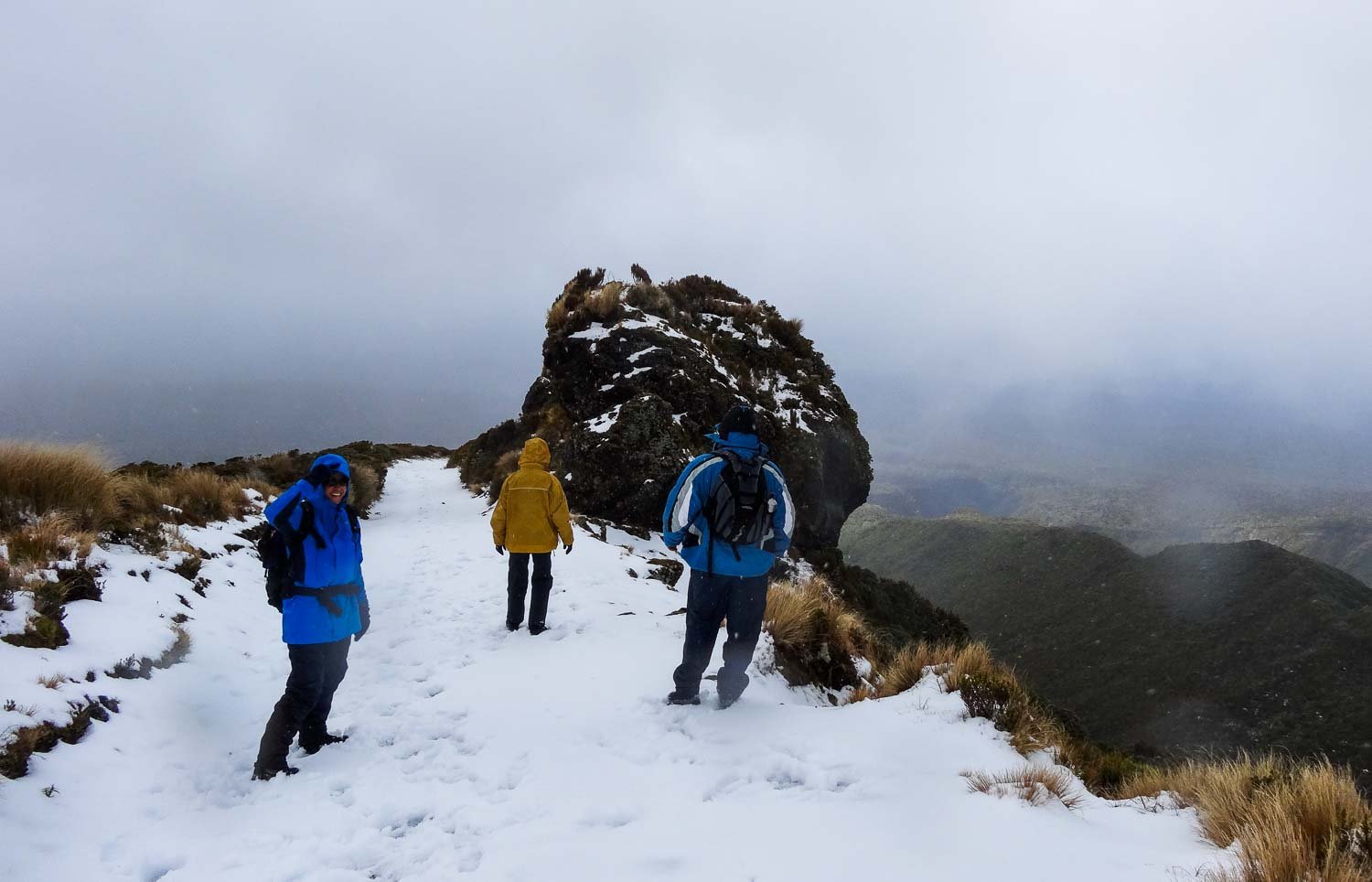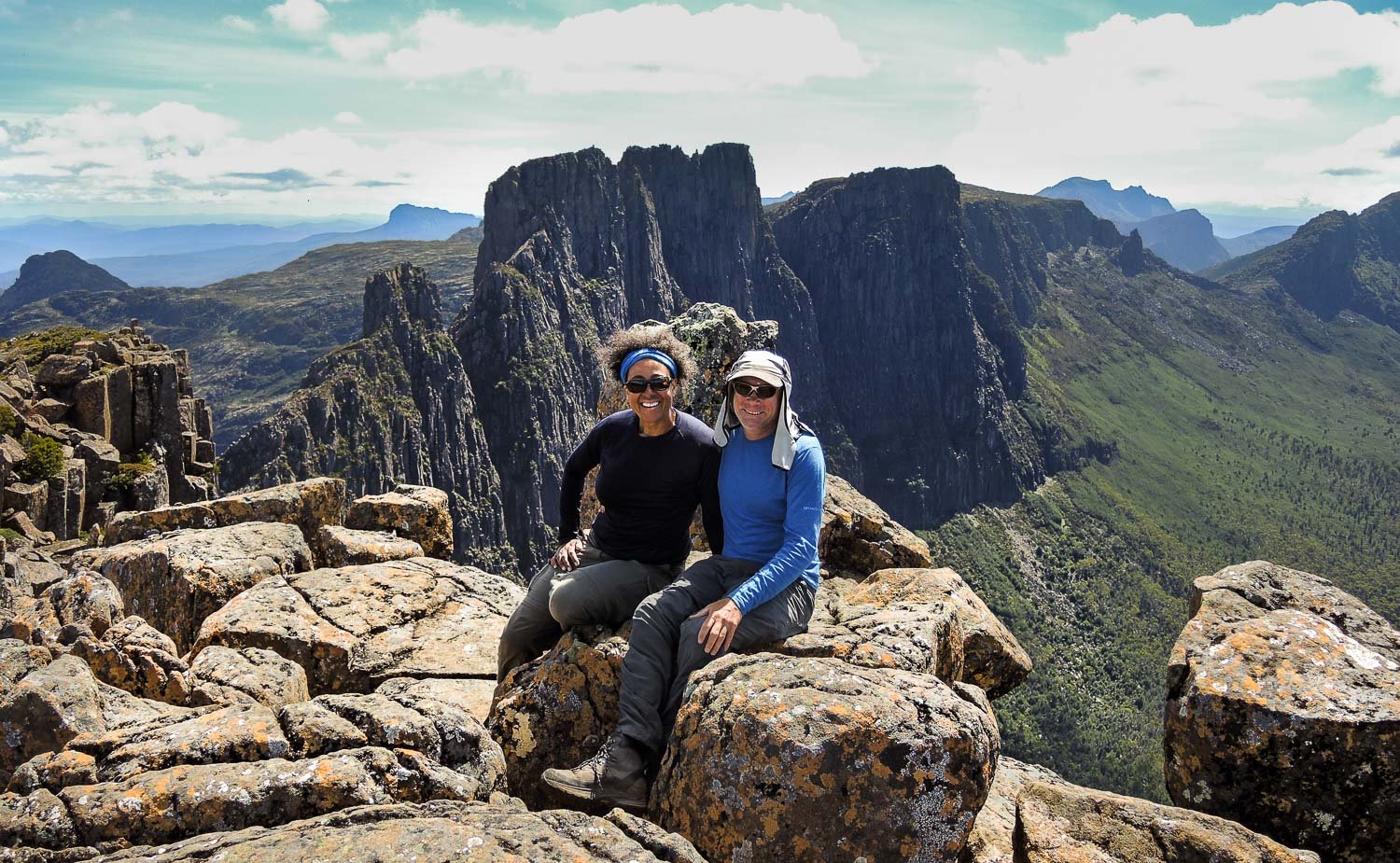How to Take a Friend on their First Multiday Hike - and Both Have Fun
Here’s a scenario. You’ve invited your new friend round for dinner. He’s mentioned he doesn’t eat much meat, is on the (alcohol) wagon and has a toddler at home, so needs to be home by 8 pm.
Lunch with Lamb,
Tour Mont Blanc.
When he arrives, you offer him a beer, and when he demurs you realise there’s not much else in the fridge except wine. Oh well. You’ve made a beautiful roast lamb, because it’s your favourite recipe and everyone loves it, and though he said he doesn’t eat much meat you bet he’ll love your lamb. It’s taking a little longer to cook than you anticipated but no matter, you’re sure his babysitter will be okay.
When you finally serve up the meal at 7:30pm, he only picks at it. And then he makes an excuse to rush home before you’ve even served up dessert! This when you’ve gone to all the trouble of inviting him and cooking a special meal!
Just as delicious as roast lamb,
but you wouldn’t serve it to a friend who is vegan or allergic to seafood, would you?
Of course, that story is a huge exaggeration because no one would treat a dinner guest like that, but I’m amazed to regularly see online the equivalent complete lack of respect and empathy when experienced hikers take their significant other or friend for their first multiday hike together. I see a lean ultra-marathon-looking lass proudly proclaiming that she and her somewhat overweight partner (panting and red-faced at her side and looking none too happy) did X miles in Y time and it was a great challenge, although admittedly Friend found it a bit tough. Well, quite tough, actually, she cried a few times but it was fun overall … wasn’t it?
There’s nothing wrong with spreading out even further than this – here, there’s an especially fast hiker at the front, but Geoff, one of the stronger hikers, is behind me bringing up the rear. The stronger men – and it can easily be women in some partnerships – are mostly carrying the gear. There were no FU Breaks. This day hike was a complete delight: a slightly modified style would have suited a multiday hike equally well!
Of course, when you are both equally experienced, you’ll sort things out between you and this blog is irrelevant. You’ll both know what distances and elevation gains and losses you’re comfortable with, and whether you’ll hike all the way together or catch up at the end of the day, or at lunchtime, or whatever suits. You’re each carrying the gear you need to navigate and be safe, and you know how to use that gear. Or perhaps you’ve divvied up gear in a way that works for you both. You respect each other’s skills and choices and come to an arrangement that suits everyone. You can do any damn thing you want.
Established and/or experienced hiking partners can do whatever they want, whether they are hares like those in the left foreground, or tortoises like Geoff and me! I’m pointing at the times on the sign, and laughing!
If you’ve hiked together successfully numerous times, don’t fix what ain’t broke. Stop reading.
But what if this is the first time your partner or friend has expressed an interest in joining you? Perhaps they enjoy day hikes, but have never done a multiday one before. Perhaps they’ve done multiday hikes, but only in supported groups. Or they may never have camped in the woods, let alone pooped in them!
If you are the more experienced hiker, and you have invited a much less experienced hiker along, then they are your guest.
Because they are a guest and presumably you want them to enjoy the experience, even repeat it, the walk is not about you. Some may disagree but we believe that, if you are treating them with genuine respect, your prime responsibility is to make the experience as enjoyable for them as possible.
Communicate, Communicate, Communicate
You may know the person very well, moderately, or hardly at all, so you may know the answers to all or none of the following questions. There are a million ways to walk, but it’s a good idea to consider the following if you are to treat your inexperienced guest with respect and ensure they – and you! – enjoy themselves.
Am I ready for the responsibility of a less experienced hiking partner?
Am I okay with altering my normal route, speed and/or routines if necessary? If our motivations are completely different – I want to push myself, he wants to meander and soak in the view – will I be happy to compromise, or should I invite someone with more compatible goals?
Geoff has gone ahead so I can get him in shot, and is now waiting for me to catch up.
What changes, if any, might I need to make to my usual daily distances?
What is their level of navigational skill?
Why does my hiking buddy want to join me? What are her motivations for the hike: nature? personal challenge? fitness? togetherness?
How do they handle climbs? descents? Do they have knee issues (steep downhills may be problematic) or ankle problems (uneven ground).
Do they have any relevant fears – heights? exposure? river crossings? snakes? bugs? sleeping alone in a tent? toileting?
Do you or they have any dietary or health considerations? It’s always sensible to share this kind of info, rather than when you’ve passed out and your partner has no idea about the epipen in the top LHS pocket of your pack!
Are they okay with pooping in the woods? A surprising number of people are not and have no idea of LNT. Have you discussed it with them? Loaned them a snow peg or ultralight trowel? This conversation is worth having before you leave home, rather than as you hand them the trowel and toilet paper. They might like to buy a pee rag or bidet. How compact or extensive is their toiletries bag? Share this ultralight toiletries article with them so they don’t overpack.
Sleeping arrangements: Are they hot or cold sleepers? Do they have their own gear? Is it suitable for the trip?
Electronic communications? Are you in phone range? Satellite range? PLBs? Each? One between two? And how will that affect your planning?
How heavy is their pack? Is it appropriate for them and their strength? If you are stronger and faster than they are, consider taking some of their heaviest gear so their pace may better match yours: loadsharing ensurs a happier hike! Or the reverse if they are stronger than you!
The stronger, faster partner can sensibly carry more if you need to maximise distance.
Is their clothing appropriate for the conditions? Many things that are automatic for experienced hikers – layering, effective raingear, no cotton, sunscreen, dry sleeping clothes (in cold conditions), worn-in hiking boots or shoes, etc – are new to inexperienced hikers, and inappropriate gear can ruin their hike.
Good rain shells are essential on some walks and, if you have invited a less experienced hiker, it is your responsibility, not theirs, to ensure they know about correct equipment. We felt bad about our friend’s jacket (far right). By lunch time, it was sodden and insanely heavy. It took days to dry.
Before the Hike
Communicate, communicate, communicate. If you don’t know each other well, discuss your goals for the upcoming walk. Discuss breaks (No FU Ones!).
Discuss distances and pace, remembering that inexperienced hikers may not know their preferred distances and speeds. If there are certain distances to be covered, can my guest maintain that pace? For how many days? Plan your hike for the slowest person in your group. Try a shakedown hike and see how they go. If you don’t think that you will cope with a much slower or faster hiker, then reconsider whether you should take them at all; a faster but inexperienced hiker – especially one with poor navigational skills – also brings challenges.
Kangaroo Island: I’m the slowest but we’ll catch up at the end of the beach.
All is well.
Discuss food. Some people carry a frypan, eggs and bacon on short trips, or frozen steaks! Food can be deal-breaking for some hiking partnerships!
Get together beforehand for a gear check. Nearly everyone packs WAY too much on their first backpacking trip!
Expect things to take longer. Setting up the tent and taking it down, cooking dinner, getting dressed, packing the backpack, breakfast cleanup… everything. Schedule your hike so it’s not rushed.
During the Hike
Then, during the hike, check in on each other. If they’re starting to lag, stop for a break or slow your pace (they are your guest). On the other hand, our lightly loaded friend on the Investigator Trail walked much faster than we did with our heavy packs until the last days, when our packs were lighter! So she walked ahead, but stopped at every intersection and certain agreed spots such as beach heads to let us catch up. We chose the spots so we’d be no more than about 25 minutes apart – not perfect, but an acceptable compromise in low risk terrain. We had done many day hikes together already, so were aware of and comfortable with her hiking ability, preferences and style.
Our friend leads the way on our walks and usually speeds ahead unless we are lightly laden, when we walk at a similar pace. And of course because I document our walks with photos, I’m always the slowest.
Provide responsibilities with support. Let them lead or help route find or carry the map. Discuss shortcuts or alternative routes.
Show your friend mapping apps such as Avenza or AllTrails that run on their phone’s gps rather than the phone network
It will make them (and you) more relaxed.
If sleeping in separate tents, cast a discreet eye over their first tent pitches, checking for common mistakes such as footprints extending beyond the fly, tent inners touching flys, and poor pegging and/or guying.
To conclude
If you keep in mind that they are your guest on the hike, you will have done everything possible to create an enjoyable experience not just for them, but for you as well. You’re serving up an appropriate meal you’ll both love, on time, with the right beverage options, and a dessert that lets your relaxed guest get home in plenty of time. If you like and respect your friend, it’s simply the right thing to do.
Hiking with a buddy or significant other is a partnership – the details are up to you, but respect, communication and empathy are key for repeat experiences!











